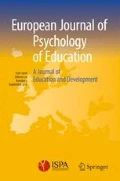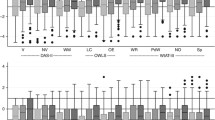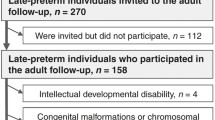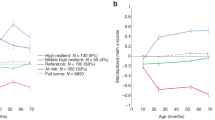Abstract
Individual differences in academic success were investigated in a geographically defined whole-population sample of very preterm children with a gestational age of less than 32 weeks or a birth weight of less than 1500 gm. The sample consisted of 264 very preterm children (75.6% of German-speaking survivors) and 264 controls matched for gender, socioeconomic status, marital status and age of mother, who were studied from birth. The present analyses focused on the impact of cognitive skills assessed at ages 6 and 8 on academic success at the age 13. IQ scores, prereading skills, reading, spelling, and math performance assessed during the last kindergarten year and again at the end of Grade 2 were used as predictors of academic success in early adolescence. Differences between very pretern children and controls in cognitive abilities already observed in earlier assessments remained stable over time, with controls on average performing more than half a standard deviation above the level of preterm children. Preterm children also performed poorer on the literacy measures and indicators of math performance. Multivariate and causal modeling revealed different prediction patterns for the two groups. Whereas IQ was particularly important for the prediction of academic success in the pre-term sample, general IQ was less relevant for the prediction of academic success in the control group. When subgroups of at-risk children were formed according to birth weight categories, we found that school problems were most pronounced for children with extremely low birth weight (1000 gm and less).
Résumé
Des différences individuelles concernant le succès académique sont recherchées en cadre d’une population géographiquement définie entière des enfants nés avant terme âgés de moins de 32 semaines avant la naissance et un poids de naissance moins de 1500 grammes. La population concernée se compose de 264 prématurés (75,6% des survivants qui parlent l’allemand) et 264 enfants pour le groupe de contrôle, géminés le sexe, l’état socio-économique, la situation de famille et l’âge de la mère, qui sont examinés depuis leur naissance. Les analyses actuelles sont pointées à l’influence des capacités cognitives reçues à l’âge de 6 et 8 ans au succès académique à l’âge de 13. Les scores de l’intelligence, les capacités avant lire, lire, épeler et la capacité en mathématiques obtenus pendant la dernière année au jardin d’enfants et de nouveau à la fin de “Grade 2” sont utilisés pour la prédiction du succès académique à l’âge adolescent. Les différences entre les prématurés et les enfants de contrôle concernant les capacités cognitives déjà observées dans les recherches précédentes restent stables tout le temps, les enfants de contrôle montrent une performance en moyen une demie déviation mieux que les prématurés. Les prématurés sont aussi pire concernant les mesures de la littérature et la performance en mathématiques. Les modèles multivariates et de causalité montrent des modèles prévoyantes différentes pour les deux groupes. Pendant que l’intelligence est particulièrement importante pour la prédiction du succès académique dans la population prématurée, l’intelligence générale est moins important pour la prédiction du succès académique dans le groupe de contrôle. Si des sous-groupes des enfants en risque sont formés accordés aux catégories du poids de naissance, on a montré que les problèmes à l’école sont particulièrement valable pour les enfants de poids extrêmement bas (1000 grammes et encore moins).
Similar content being viewed by others
References
Asendorpf, J., & van Aken, M.A.G. (1993). Deutsche Version der Selbstkonzeptskalen von Harter [German version of the Harter self concept scales],Zeitschrift für Entwicklungspsychologie und Pädagogische Psychologie, 25, 64–86.
Avon Premature Infant Project (APIP). (1998). Randomised trial of parental support for families with very preterm children.Archives of Disease in Childhood — Fetal Neonatal Edition, 79(1), 4–11.
Aylward, G.P., Pfeiffer, S.I., Wright, A., & Verhulst, S.J. (1989). Outcome studies of low birth weight infants published in the last decade: A meta-analysis.Journal of Pediatrics, 115, 515–520.
Bauer, A. (1988).Ein Verfahren zur Messung des für das Bildungsverhalten relevanten Sozial-Status (BRSS) Überarbeitete Fassung [A measure assessing SES in Germany, revised version]. Frankfurt: Deutsches Institut für Internationale Pädagogische Forschung.
Bentler, P.M. (1990). Comparative fit indexes in structural models.Psychological Bulletin, 107, 238–246.
Bhutta, A.T., Cleves, M.A., Casey, P.H., Cradock, M.M., & Anand, K.J. (2002). Cognitive and behavioral outcomes of school-aged children who were born preterm: A meta-analysis.Journal of the American Medical Association, 288(6), 728–737.
Botting, N., Powls, A., & Cooke, R.W.I. (1997). Attention deficit hyperactivity disorders and other psychiatric outcomes in very low birth weight children at 12 years.Journal of Developmental and Behavioral Pediatrics, 38, 931–941.
Botting, N., Powls, A., Cooke, R.W., & Marlow, N. (1998). Cognitive and educational outcome of very-low-birthweight children in early adolescence.Developmental Medicine and Child Neurology, 40, 652–660.
Bradley, L., & Bryant, P.E. (1983). Categorizing sounds and learning to read — A causal connection.Nature, 301, 419–21.
Brandt, I. (1983).Griffiths Entwicklungsskalen (GES) zur Beurteilung der Entwicklung in den ersten beiden Lebensjahren [Griffith Development Scales for the first two years of life]. Weinheim: Beltz.
Bryant, P., MacLean, M., & Bradley, L. (1990). Rhyme, language, and children’s reading.Applied Psycholinguistics, 11, 237–252.
Burgemeister, B., Blum, L., & Lorge, J. (1972).Columbia Mental Maturity Scale. New York: Harcourt Brace Jovanovich, Inc.
Bus, A., & van Ijzendoorn, M. (1999). Phonological awareness and early reading. A meta-analysis of experimental training studies.Journal of Educational Psychology, 91, 403–414.
Caughy, M.O. (1996). Health and environmental effects on the academic readiness of school-age children.Developmental Psychology, 32, 515–522.
Cohen, S.E., Beckwith, L., Parmelee, A.H., Sigman, M., Asarnow, R., & Espinosa, M.P. (1996). Prediction of low and normal school achievement in early adolescents born preterm.Journal of Early Adolescence, 16, 46–70.
Escobar, G.J., Littenberg, B., & Pettiti, D.B. (1991). Outcome among surviving very low birthweight infants: A meta-analysis.Archives of the Disabled Child, 66, 204–211.
Fergusson, D.M., & Woodward, L.J. (1999). Maternal age and educational and psychosocial outcomes in early adulthood.Journal of Child Psychology and Psychiatry, 40, 479–489.
Friedman, S.L., & Sigman, M.D. (1992). Past, present, and future directions in research on the development of low birthweight children. In S.L. Friedman & M.D. Sigman (Eds.),The psychological development of low birthweight infants. New Jersey: Ablex Publishing Cooperation.
Goswami, U. (1990). A special link between rhyming skill and the use of orthographic analogies by beginning readers.Journal of Child Psychology and Psychiatry, 31, 301–311.
Grimm, H., & Schöler, H. (1991).Heidelberger Sprachentwicklungstest (HSET). Göttingen: Hogrefe.
Grissemann, H. (2000).Züricher Lesetest (ZLT;6th ed.). Göttingen: Hogrefe.
Gutbrod, T., Wolke, D., Soehne, B., & Riegel, K. (2000). The effects of gestation and birthweight on the growth and development of very low birthweight small for gestational age infants: A matched group comparison.Archives of Disease in Childhood Fetal and Neonatal Edition, 82, F208-F214.
Hack, M., Klein, N., & Taylor, H. G. (1995). Long-term developmental outcomes of low birth weight infants.The Future of Children, 5, 176–196.
Harter, S., & Pike, R. (1984). The pictorial scale of perceived competence and social acceptance for young children.Child Development, 55, 1969–1982.
Hille, D., Den Ouden, A.L., Bauer, L., Brand, R., & Verloove-Vanhorick, S. (1994). School performance at nine years of age in very premature and very low birth weight infants: Perinatal risk factors and predictors at five years of age.Journal of Pediatrics, 125, 426–434.
Hille, E.T.M., den Ouden, A.L., Saigal, S., Wolke, D., Lambert, M., Whitaker, A., Pinto-Matrin, J.A., Hoult, L., Meyer, R., Verloove-Vanhorick, S.P., & Paneth, N. (2001). Behavioural problems in children who weight 1000g or less at birth in four countries.The Lancet, 357, 1641–1643.
Hu, L., & Bentler, P.M. (1998). Fit indices in covariance structural modeling: Sensitivity to underparameterized model misspecification.Psychological Methods, 3, 424–453.
Kaufman, A., & Kaufman, N. (1983).Kaufman Assessment Battery for Children. Circle Pines, MN: American Guidance Service.
Klebanov, P.K., Brooks-Gunn, J., & McCormick, M.C. (1994). School achievement and failure in very low birth weight children.Journal of Developmental and Behavioral Pediatrics, 15, 248–256.
Koeppen-Schomerus, G., Eley, T.C., Wolke, D., Gringras, P., & Plomin, R. (2000). The interaction of prematurity with genetic and environmental influences on cognitive development of twins.The Journal of Pediatrics, 137, 527–533.
Landry, S.H., Fletcher, J.M., Denson, S.E., & Chapieski, M.L. (1993). Longitudinal outcome for low birth weight infants: Effects of intraventricular hemorrhage and bronchopulmonary dysplasia.Journal of Clinical and Experimental Neuropsychology, 15, 205–218.
Landry, S.H., Smith, K.E., Miller-Loncar, C.L., & Swank, P.R. (1997). Predicting cognitive-language andsocial growth curves from early maternal behaviors in children at varying degrees of biological risk.Developmental Psychology, 43, 1040–1053.
Leon-Villagra, J., & Wolke, D. (1993).Pseudoword reading test. Munich: Unpublished Mannuscript.
McCarton, C.M., Brooks-Gunn, J., Wallace, I.F., Bauer, C.R., Bennett, F.C., Bernabaum, J.C., Broyles, S., Casey, P.H., McCormick, M.C., Scott, D.T., Tyson, J., Tonascia, J., & Meinert, C.L. (1997). Results at 8 years of early intervention for low-birth-weight premature infants — The Infant Health and Development Program.Journal of American Medical Association, 277, 126–132.
McCormick, M., Gortmaker, S., & Sobol, A. (1990). Very low birth weight children: Behavior problems and school difficulty in a national sample.The Journal of Pediatrics, 117, 688–693.
Melchers, P., & Preuss, U. (1991).K-ABC: Kaufman Assessment Battery for Children: Deutschsprachige Fassung. Frankfurt, AM: Swets & Zeitlinger.
Müller, R. (1983).Diagnostischer Rechischreibtest DRT 2 [Diagnostic spelling test for Grade 2]. Weinheim: Beltz.
Ornstein, M., Ohlsson, A., Edmonds, J., & Asztalos, E. (1991). Neonatal follow-up of very low birthweight/extremly low birthweight infants to school age: A critical overview.Acta Paediatrics Scandinavia, 80, 741–748.
Raz, R.S., & Bryant, P. (1990). Social background, phonological awareness and children’s reading.British Journal of Developmental Psychology, 8, 209–225.
Riegel, K., Ohrt, B., Wolke, D., & Österlund, K. (1995).Die Entwicklung gefährdet geborener Kinder bis zum fünften Lebensjahr [The development of prematurely born children from birth to age 5]. Stuttgart: Enke.
Ross, G., Lipper, E., & Auld, P. (1991). Educational status and school-related abilities of very low birth weight premature children.Pediatrics, 88, 1125–1134.
Saigal, S., Hoult, L.A., Streiner, D.L., Stoskopf, B.L., & Rosenbaum, P.L. (2000). School difficulties at adolescence in a regional cohort of children who were extremely low birth weight.Pediatrics, 105, 325–331.
Saigal, S., Szatmarl, P., Rosenbaum, P., Campbell, D., & King, S. (1991). Cognitive abilities and school performance of extremely low birth weight children and matched control children at age 8 years: A regional study.Journal of Pediatrics, 118, 751–760.
Saigal, S., den Ouden, L., Wolke, D., Hoult, L., Pameth, N., Streiner, D., Whitaker, A., & Pinto-Martin, J. (2003). School-age outcomes in children who were extremely low birth weight from four international population-based cohorts.Pediatrics, 112, 943–950.
Sameroff, A.J., Seifer, R., Baldwin, A., & Baldwin, C. (1993). Stability of intelligence from preschool to adolescence: The influence of social risk-factors.Child Development, 64, 80–97.
Schneider, W. (1993). Introduction: The early prediction of reading and spelling.European Journal of Psychology of Education, 8, 199–203.
Schneider, W., & Näslund, J.C. (1999). Impact of early phonological processing skills on reading and spelling in school: Evidence from the Munich Longitudinal Study. In F.E. Weinert & W. Schneider (Eds.),Individual development from 3 to 12: Findings from the Munich Longitudinal Study (pp. 126–147). Cambridge, UK: Cambridge University Press.
Schneider, W., Roth, E., & Ennemoser, M. (2000). Training phonological skills and letter knowledge in children at risk for dyslexia: A comparison of three kindergarten training programs.Journal of Educational Psychology, 92, 284–295.
Schoon, I., Bynner, J., Joshi, H., Parsons, S., Richard, D., & Sacker, A. (2002). The influence of context, timing and duration of risk experiences for the passage from childhood to mid adulthood.Child Development, 73, 1486–1504.
Schothorst, P.F., & van Engeland, H. (1996). Long-term behavioral sequelae of prematurity.Journal of the American Academy of Child and Adolescent Psychiatry, 35, 175–183.
Skowronek, H., & Marx, H. (1989). The Bielefeld longitudinal study on early identification of risks in learning to read and write: Theoretical background and first results. In M. Brambring, M. Lösel, & H. Skowronek (Eds.),Children at risk: Assessment, longitudinal research and intervention (pp. 268–294). New York: De Gruyter.
Skuse, D. (1999). Survival after being born too soon, but at what cost?The Lancet, 354, 354–355.
Sommerfelt, K., Ellertsen, B., & Markestad, T. (1993). Personality and behavior in eight-year-old children with birth weight under 1500g.Acta Paediatrica, 82, 723–728.
Steiger, J.H. (2000). Point estimation, hypothesis testing, and interval estimation using the RMSEA: Some comments and a reply to Hayduk and Glaser.Structural Equation Modeling, 7, 149–162.
Stigler, J.W., Lee, S.-Y., & Stevenson, H.W. (1990).Mathematical knowledge of Japanese, Chinese, and American elementary school children. Reston, Virginia: The National Council of Teachers of Mathematics.
Taylor, H.G., Klein, N., Minich, N.M., & Hack, M. (2000). Middle school-age outcomes in children with <750g birthweight.Child Development, 71, 1495–1511.
Taylor, H.G., Minich, N.M., Klein, N., & Hack, M. (in press). Verbal memory deficits in children with <750g birthweight.Child Neuropsychology.
Wagner, R., & Torgesen, R. (1987). The nature of phonological processing and its causal role in the acquistion of reading skills.Psychological Bulletin, 101, 192–212.
Weindrich, D., Jennen-Steinmetz, Ch., Laucht, M., Esser, G., & Schmidt, M.H. (2000). Epidemiology and prognosis of specific disorders of language and scholastic skills.European Child & Adolescent Psychiatry, 9, 186–195.
Whitfield, M.F., Grunau, R.V.E., & Holsti, L. (1997). Extremely premature (800g) schoolchildren: Multiple areas of hidden disability.Archives of Disease in Childhood, 77, 85–90.
Wimmer, H. (1996). The nonword reading deficit in developmental dyslexia: Evidence from children learning to read German.Journal of Experimental Child Psychology, 61, 80–90.
Wolke, D. (1997). The preterm responses to the environment — Longterm effects? In F. Cockburn (Ed.),Advances in perinatal medicine (pp. 305–314). Carnforth, GB: Parthenon Publishing.
Wolke, D. (1998). The psychological development of prematurely born children.Archives of Disease in Childhood, 78, 567–570.
Wolke, D., & Leon-Villagra, J. (1993).Mathematiktest fuer Grundschulkinder [Math test for elementary school children]. Munich: Bavarian Longitudinal Study.
Wolke, D., & Meyer, R. (1999). Cognitive status, language attainment and pre-reading skills of 6 year-old very preterm children and their peers: The Bavarian Longitudinal Study.Developmental Medicine and Child Neurology, 41, 94–109.
Wolke, D., & Schulz, J. (1999). Methoden und Kriterien entwicklungsorientierter Evaluation [Methods and criteria related to developmental evaluation procedures]. In G. Röper & G. Noam (Eds.),Klinische Entwicklungspsychologie: Ein Lehrbuch. Weinheim: Psychologie Verlagsunion.
Wolke, D., Schulz, J., & Meyer, R. (2001). Entwicklungslangzeitfolgen bei ehemaligen, sehr unreifen Frühgeborenen [Long-term effects of developmental problems in VLBW children].Monatsschrift für Kinderheilkunde, 149(Supplement 1), 53–61.
Wolke, D., Ratschinski, G., Ohrt, B., & Riegel, K. (1994). The cognitive outcome of very preterm infants may be poorer than often reported: An empirical investigation of how methodological issues make a big difference.European Journal of Pediatrics, 153, 906–915.
Zelkowitz, P., Papageorgiou, A., Zelazo, P.R., & Weiss, M.J.S. (1995). Behavioral adjustment in very low and normal birth weight children.Journal of Clinical Child Psychology, 24, 21–30.
Author information
Authors and Affiliations
Additional information
Research on this project was financially supported by a grant of the German Research Foundation (Deutsche Forschungsgemeinschaft) to Wolfgang Schneider and Dieter Wolke (SCHN 315/15-1).
Rights and permissions
About this article
Cite this article
Schneider, W., Wolke, D., Schlagmüller, M. et al. Pathsways to school achievement in very preterm and full term children. Eur J Psychol Educ 19, 385–406 (2004). https://doi.org/10.1007/BF03173217
Received:
Revised:
Issue Date:
DOI: https://doi.org/10.1007/BF03173217




